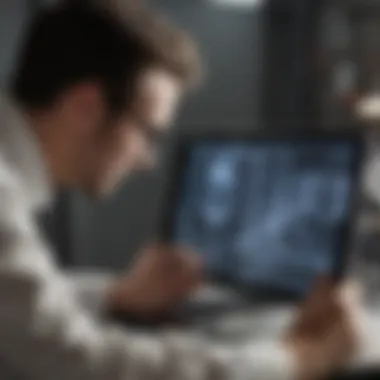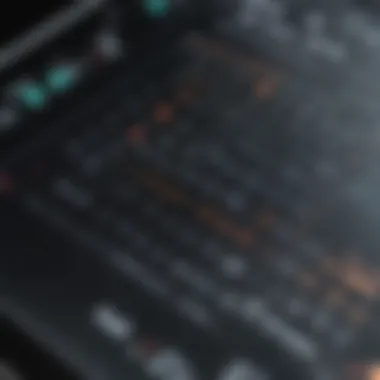Maximizing the Potential of Photo Measurement Apps


Intro
Measuring and evaluating space accurately is crucial across various disciplines, including architecture, engineering, and personal projects. As technology advances, photo measurement applications have emerged as indispensable tools for professionals and casual users alike. These apps leverage the power of smartphones, particularly on platforms such as Apple, to provide users with reliable measurement solutions using just images.
The significance of these tools cannot be overlooked. They offer a blend of convenience and precision, particularly in circumstances where traditional measuring methods are cumbersome or impractical. Understanding how to effectively utilize these applications transforms the way individuals approach their projects—streamlining workflows and enhancing accuracy.
This article seeks to thoroughly examine the landscape of photo measurement applications, aiming to educate readers about their functional capabilities and overall importance. We will explore popular apps, assessing their features and ease of use, leading to common questions concerning the accuracy of the measurements they provide. Additionally, insight into future trends will inform users of what enhancement may arrive on the horizon.
Discerning the specific needs related to measuring applications enhances user experience while optimizing workflows. Therefore, becoming acclimated with this technology is essential, particularly for those operating in fields that rely on precision measurements.
Next, we detail the notable applications shaping this space, joined by an analysis of their strengths and weaknesses.
Prologue to Measurement Photo Applications
The advent of flexible and accurate measurement photo applications has transformed not only individual tasks but also numerous professional fields. These applications harness advanced technology, including augmented reality and high-resolution imaging, to facilitate precise measurement directly from photographs. Their significance lies in their ability to streamline workflows, increase productivity, and enhance precision in environments like architecture and engineering.
Definition and Purpose
Measurement photo applications serve to capture images and subsequently derive measurements from those images with accuracy. These tools employ a range of techniques from simple linear measurements to complex area calculations, aligning with various user needs. Primarily, the purpose of these applications is to augment traditional methods of measurement, providing a more versatile and accessible alternative. By simplifying the measurement process, these tools enable professionals to focus better on their core tasks, making them an integral part of modern technology.
Evolution of Measurement Tools
The transition from manual measuring tools to digital options marks a crucial evolution in the sphere of measurements. In earlier times, professionals relied heavily on theodolites, tape measures, and rulers. Over time, technological advancements have led to the emergence of digital devices and, subsequently, smartphone-based measurement applications.
These applications represent a significant leap, integrating sophisticated algorithms with mobile technology. They now allow users to measure distances, areas, and volumes with just a few taps on their devices. This evolution signifies the shift toward a more efficient, user-friendly approach, favoring speed and accuracy in time-sensitive projects.
"The integration of technology into measurement has not only opened new avenues for precision but also redefined how professionals approach their work."
In summary, the potency of measurement photo applications is evident in not only ease of use but also their crucial role in improving accuracy across various fields. For fields reliant on spatial judgment, these tools present an invaluable option, propelling industries toward greater efficiency and effectiveness.
How Measurement Photo Apps Work
Understanding how measurement photo applications operate is crucial to fully appreciate their utility and effectiveness. These applications have been designed to cater to a variety of user needs, ranging from casual home users to professional architects or engineers. By breaking down complex measurement systems into intuitive and ;user-friendly interfaces, these apps facilitate accurate measurements in real time.
Moreover, individuals and organizations can gather precise information without needing expensive tools. The importance of how measurement photo apps work cannot be overstated. Whether for dividing spaces in home renovation or calculating angles in architectural design, these applications provide effortless and immediate results that compare favorably against traditional methods.
Core Technology Behind Measuring Apps
The backbone of measuring photo applications hinges on a few core technologies. At the heart of it all lies Augmented Reality (AR) and depth-sensing technology. AR enables users to visualize dimensions within a real-world setting using smartphone cameras. By overlaying critical measurement data directly onto a user's view, an application transforms simple snapshots into invaluable tools or frameworks.
A technology called depth perception assists in accurately grasping the spaces captured within images. By utilizing sensor data, applications can manage spatial relationships accurately. This ensures that distance and size are calculated with a degree of precision that manual measurements might fail to achieve.
In addition, some advanced applications utilize computer vision and image processing techniques. This development in computation allows measurement photo apps to recognize various objects and surfaces. As technology continues to progress, reliance on sophisticated algorithms increases, which may lead to even more accurate measurement capabilities.
Types of Measurement Methods
Measurement photo applications provide a range of methods, designed to meeting the diverse needs of users across various fields. Here, three distinct measurement approaches are evident.
Linear Measurements
Linear measurements represent the simplest form of measurement these applications provide. This method essentially measures straight-line distances between two points, a core feature in architecture or construction workflows. The key characteristic of linear measurements is its simplicity; users need only aim their device at the two endpoints to receive immediate measurements.
One significant advantage of this method lies in its speed. Users can take multiple measurements in mere moments. However, the downside is the potential for inaccuracies in difficult environments. Users must ensure the endpoints are correctly identified, as errors may occur due to obstructions or misalignment. Essentially, linear measurements offer a quick and easy method, although users must maintain diligence for optimal results.
Area Calculations


Area calculations go beyond basic linear measurements, providing insight into spatial dimensions that are essential for both design and practical use alone. The area represents a total two-dimensional space, allowing individuals to assess the floor and wall areas among other essential characteristics.
a core characteristic of area calculations is its versatility and relevance to various projects such as landscaping or construction. Accurate area calculations help stakeholders to define their requirements, adapt their materials and ensure compliance with building codes. However, determining the area can be complex, particularly when dealing with irregular shapes.
Users should recognize that various tools are provided for transforming three-dimensional shapes into flat representations, offering efficiency despite the method's potential complications.
Volume Estimation
Volume estimation represents a critical measurement for engeineering and material usage assessments. It determines the amount of physical space an object occupies. This method plays an especially important role in project evaluations within construction, logistics, and more.
The hallmark of volume estimation is its capability to provide you three-dimensional insights that linear measurements simply cannot achieve. While efficiencies in material calculations from proper volume estimations can elevate entire projects. However, potential disadvantages may apply, such as user error in capturing various measurements accurately, elongating unavoidable project delays due to improper estimations.
In summary, volume estimations stand as a strong option; thus it becomes necessary for a project as users often need an overview of resource needs. Streamlined measurements performs in helping to cater various tailored solutions accurately.
Features of Leading Measurement Photo Apps
The functionality of measurement photo applications is largely determined by their features. Understanding these features ensures users can maximize the potential of the app. Leading apps are designed with varying capabilities, each enhancing user experience by targeting specific needs. This section provides insights into user interface design, integration opportunities, as well as accuracy and calibration considerations, helping users make informed choices.
User Interface Design
User interface design is crucial for measurement photo apps. A well-crafted interface directly influences usability and satisfaction. Users should find it intuitive to navigate and employ tools to achieve desired results. For instance, an app that allows for easy toggling between measurement modes optimizes workflows. Key attributes of successful interfaces include:
- Clarity: Elements should be clearly labeled, and the layout easy to follow.
- Responsiveness: The app should function seamlessly on various Apple devices.
- Simplicity: Overly complex features can burden even expert users.
All these aspects contribute to an efficient user journey, ultimately enshrining these apps as essential tools for professionalism in different fields.
Integration with Other Tools
The ability to integrate with other tools enhances the versatility of measurement photo applications. This integration often lends itself to improved workflows, particularly in professional contexts. For example, many measurement apps provide compatibility with design software like AutoCAD or project management tools such as Trello. The primary advantages include:
- Data Synchronization: Users can import or export measurements to other software.
- Collaboration: Multiple users can work on a project simultaneously, maintaining consistency across platforms.
- Enhanced Functionality: Integration with tools like Google Drive or Dropbox ensures users have access to files and results on-the-go.
In the competitive landscape of measurement applications, proper develoment and incorporation of these integrations can keep the app relevant.
Accuracy and Calibration
The precision of measurement tools hinges on their accuracy and calibration capabilities. Users expect an app to deliver reliable measurements before making rough estimates or executing designs. Hence, accuracy isn't just a feature; it's a benchmarket against which all measurement tools should be judged. Effective calibration features ensure that real-world deviations are adjusted. This entails:
- Calibration Procedures: Easy-to-follow steps enable users to ensure their measurements are right.
- Error Notifications: Alerts that indicate when measurements might be inaccurate allow adjustments before final use.
In this rapidly advancing technological environment, maintaining accuracy sets the bar higher for measurement photo applications. A genuine appreciation for this element can keep professionals informed about their toolsets and enhance their work outcomes.
Popular Measurement Photo Applications for Apple Devices
Overview of Top Apps
Measure App by Apple
The Measure App by Apple is notable for its direct integration into iOS, making it an immediate choice for many users. This native application boasts a learner-friendly interface. A key characteristic of the Measure App is its use of augmented reality to enhance measurement accuracy. By tapping on the screen and dragging a line between two points, users can measure lengths easily.
Another unique feature of the Measure App is its ability to measure dimensions of objects, providing real-time data using the device's camera. Although it can vary in precision especially in low-light conditions, its accessibility makes it a familiar choice for casual users.
EasyMeasure
EasyMeasure works uniquely by utilizing the iPhone’s camera to measure distances and lengths. It provides an alternative for those who seek precise calculations without overly complex interfaces. The app stands out for its simplicity, allowing users to point at an object and instantly receive size information.


The main benefit of EasyMeasure lies in its quick calibration process. However, the accuracy might decrease over longer distances, making it less effective in large-scale applications where precise measurements are necessary.
AR Ruler App
The AR Ruler App specializes in dynamic measurements by leveraging augmented reality. Users can map their environment through the camera, providing dimensional insights for any space. A significant characteristic of AR Ruler App is its suite of customizable measurement parameters.
The unique advantage of this app is the flexibility it offers users to calculate areas, volumes, and even create floor plans. However, its performance can be inconsistent in dark or cluttered environments, requiring clean visuals for optimal accuracy.
Comparison of Features
Comparing these applications reveals nuanced advantages depending on specific use cases:
- Functionality: Measure App offers reliability within the Apple ecosystem; EasyMeasure focuses on uncomplicated usability; while AR Ruler provides advanced feature set.
- Accuracy: Measure App is susceptible to conditions, EasyMeasure is straightforward but may lack depth, and AR Ruler excels in extensive calculations where conditions are favorable.
- Interface: Measure App retains a native feel, EasyMeasure favors minimalism, and AR Ruler demands more engagement to explore all features.
Understanding these distinctions helps users choose the most effective measurement tool for their needs, elevating their experiences with photo measurement applications.
Each of these applications alters workflow. Selecting based on individual need keeps users proficient and precise.
Use Cases in Various Fields
Utilizing measurement photo applications has immense significance across a variety of sectors. These tools streamline processes and enhance precision in tasks where traditional measuring methods may fall short. Understanding the specific use cases in fields such as architecture, engineering, and personal projects provides valuable insights. Each sector benefits from unique characteristics of these apps, transforming how professionals and individuals perceive measurement.
Architecture and Design
In architecture and design, photo measurement applications facilitate accurate inputs during project planning and assessment. Common tasks include drafting dimensions, assessing site contours, and evaluating space. By enabling designers to capture measurements directly from their devices, these apps reduce reliance on manual tools like tape measures. The ability to visualize dimensions within photographs allows for lightning-fast revisions.
Key Benefits:
- Efficiency: Architects can bypass prolonged measurements, saving time.
- Visual Clarity: Measurements overlaid on visual graphics help convey ideas more concretely.
- Immediate Adjustments: Easily adjust space constraints based on observed data leading to better-informed designs.
Despite these advantages, professionals must regard accuracy limitations inherent in photo measurement apps compared to classic tools. Environmental factors such as light and angle play a crucial role. Hence, understanding each application's calibration is critical to achieving proficient results.
Engineering Applications
The engineering field leverages photo measurement applications for a range of tasks, from fieldwork to product development. The functionality to measure dimensions during site inspections promotes regular evaluation. Engineers can also streamline collaboration with teams, ensuring everyone operates from the same data without needing physical devices.
Considerations Include:
- Precision Needs: Establish standard operating procedures while utilizing measurement tools for benchmarking. Their variance and interpretation must align with compliance requirements, especially in construction.
- Real-Time Collaboration: Share measurements rapidly among team members, facilitating seamless adjustments in documentation and plans.
- Documentation and Reporting: As stakeholders require precise evidence, in-app reporting functionalities gain relevance.
Engineers must remain vigilant about the integration of these tools with established workflows. Operators using these applications without proper training and calibration may unintentionally miscommunicate data crucial for project completion.
Personal Projects
For more informal yet equally significant applications, personal projects offer another aspect of how measuring photo apps are utilized. Individuals embarking on home renovation, crafting, or other DIY undertakings find these tools indispensable. The capability to measure spaces quickly allows them to make educated decisions grounded in reliable data.
Practical Uses:
- Home Improvements: Measure room dimensions when selecting furniture or planning layouts efficiently.
- Crafting and DIY: Capture essential sizes for artwork or installation; helps to minimize waste of materials.
- Event Planning: Control spacing and arrangement for gatherings utilizing continuous measuring without multiple retrials.
In some cases, achieving measures through photo applications can supplement or replace traditional methods for quick, simple projects. However, users should balance convenience with diligence to ensure that oversight is not a risk, particularly in critical measurements that may have an impact on function or aesthetics.
Utilizing photo measurement apps brings about advantages, but understanding their limitations within specific use cases is fundamentally important for achieving accuracy and suitability in tasks.
User Experience and Feedback


User experience (UX) is a critical component in the success of photo measurement applications. A well-designed app enhances user satisfaction, fostering engagement and trust. Feedback plays an equally crucial role, offering developers insights to refine their apps. Both elements impact how effectively users leverage these applications.
User Demographics
Understanding user demographics is vital for tailoring measurement photo applications to suitable audiences. Different user groups may have distinct needs and preferences. For instance, architecture students might prioritize detailed architectural features, while DIY enthusiasts could focus on practicality and ease of use.
Research indicates that users fall into various age groups and professional backgrounds, influencing their interaction with technology. For example:
- Young professionals prefer intuitive interfaces.
- Engineers seek precision and advanced analytics.
- Casual users want simplicity without sacrificing accuracy.
Educating user segments about app functionality can significantly enhance their experience.
Common Challenges
Despite advancements, users face several challenges when utilizing measurement photo applications. Understanding these can improve app development and user satisfaction. Here are recurring difficulties:
- Accuracy Issues: Users often question the precision of measurements. Factors like camera quality and environment impact accuracy.
- Learning Curve: New users might struggle with complicated interfaces. Comprehensive tutorials can help ease this transition.
- Limited Features: Some apps may not cater to specific professional needs, leading to frustration.
- Technical Compatibility: Compatibility with devices can also be an obstacle, especially across different Apple devices and versions.
Addressing these challenges head-on is crucial for fostering a positive user experience and retaining a loyal customer base. Continuous gathering of user feedback helps app developers identify areas needing improvement.
Future Trends in Measurement Photo Applications
The realm of measurement photo applications is poised for significant transformation. This section centers on trends shaping the landscape. Recognizing these advancements becomes vital as they optimize efficiency and redefine accuracy across various sectors. Key trends influencing this space include augmented reality enhancements and the integration of artificial intelligence. Embracing these trends can help users adapt and make the most of these innovative tools.
Advancements in Augmented Reality
Augmented reality (AR) is rapidly changing how users engage with measurement photo applications. Unlike traditional methods, AR overlays digital information onto the real-world environment, merging the virtual and tactile. This technology allows users to visualize spatial relationships more aptly, elevating the measurement experience.
Some primary benefits of AR include:
- Enhanced Precision: AR enables users to capture dimensions directly in the environment with greater accuracy than previous methods.
- Real-Time Feedback: Changes can be immediately reflected, and parameters adjusted on the go, reducing errors.
- User Engagement: The interactive nature of AR applications often increases user interest and understanding of measurement tasks.
For applications liike Measure App by Apple, leveraging AR can drastically improve usability. As these tools continue to evolve, the synergy between AR and measurement tools can provide unique usage scenarios across specialized fields, such as architecture and construction.
AI Integration in Measuring Apps
AI is significantly affecting how measurement photo applications function. Safeguarding robust algorithms that interpret data more efficiently promotes different user applications. AI has the capability to learn user preferences, making the tools increasingly personalized over time. This intelligence creates seamless integration and boosts functionality.
Here are key aspects of AI in measuring apps:
- Automated Analysis: Machine learning facilitates automatic shape recognition and measurement without extensive manual input.
- Enhanced Accuracy: Over time, AI can correct inherent biases or common errors discovered during measurement processes.
- User Support: Chatbots or integrated help functions powered by AI can guide new users in navigating the intricate features typical of measurement applications.
A great example of AI application in measurement tools is EyeMeasure, where real-time correction assists architects through scanning and interpretation of space configuration. As the future unfolds, prioritizing AI development involves creating a blend of efficiency, accuracy, and user-tailored experiences.
Culmination
In the context of this article, the conclusion synthesizes the key aspects of photo measurement applications. It encapsulates the discussions about their functionality, application in various sectors, user experiences, and future advancements in technology. Understanding these components is crucial for effective utilization of these tools.
Summary of Key Points
Photo measurement applications have reshaped how professionals engage with measurements in fields such as architecture, engineering, and personal projects. Here are some critical takeaways:
- Concept and Evolution: Measurement applications combine technology and user-focused design, showcasing rapid progress within the digital landscape.
- Core Functionality: These apps utilize augmented reality and advanced calibration methods, ensuring high accuracy in linear measurements, area calculations, and volume estimation.
- Popular Performers: Applications like the Measure App by Apple excel in user interface and tool integration. Comparisons reveal strengths in various aspects.
- Real-World Applications: The significant impact of these apps offers tangible benefits in professional settings by enhancing the precision of measurements.
- User Insights: Functionalities are crafted to meet the diverse needs across distinct user demographics, revealing areas where enhancements may further improve experience.
- Future Directions: Anticipating advances in technology suggests the potential of integrated AI tools, enriching these applications’ reliability and ease of use.
Implications for Users
The implications of using measurement photo applications are multifaceted. Users can expect distinct outcomes from their adoption, shaping both professional practices and personal projects in the following ways:
- Enhanced Efficiency: Time saved in measurement processes promptly translates to improved productivity.
- Cost-effectiveness: As these applications eliminate the need for many physical measuring tools, users can save both money and space.
- Skill Accessibility: Advanced measuring capabilities now lie within the palms of many, enabling lower skill barriers for proficient calculation tasks.
- Integration Opportunities: Users can benefit from seamless connectivity with other digital tools and applications, fortifying overall project workflows.
- Future Readiness: As the landscape evolves, staying updated on emerging tools ensures users remain competitive in their respective fields.
The technological transformations regarding photo measurement applications highlight their relevance in practical measurement methodologies, reflecting user needs and the importance of continual appreciation for precision in a fast-paced world of innovation.



